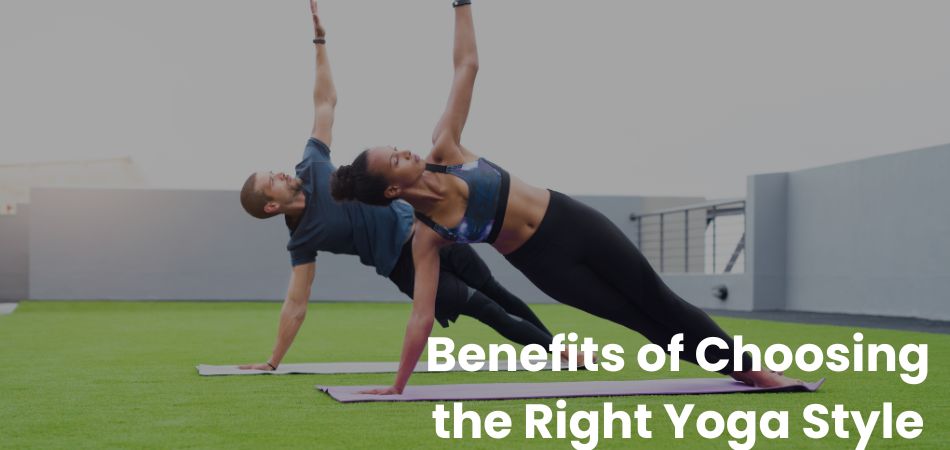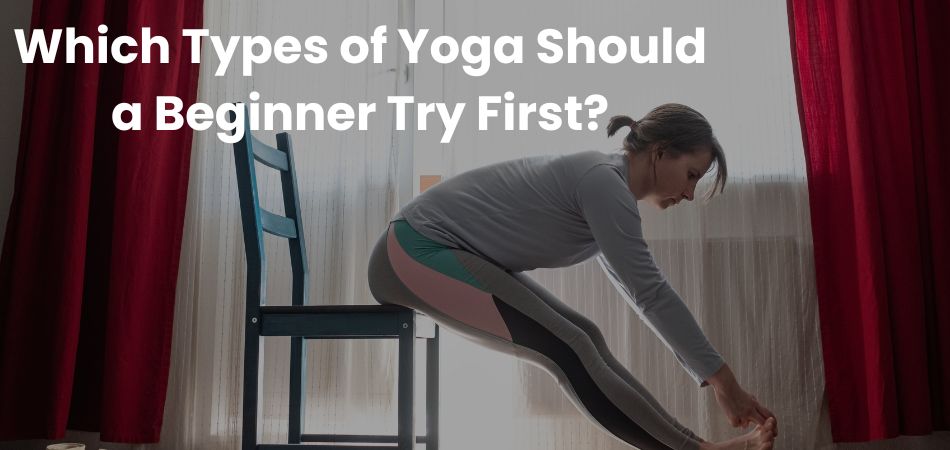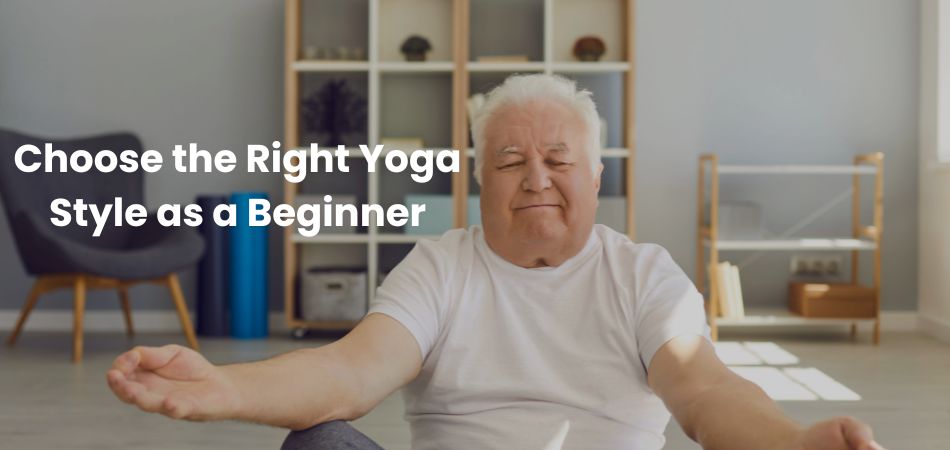The different styles of yoga can make starting your yoga journey both exciting and overwhelming. Each type of yoga offers a range of benefits, according to different preferences and fitness levels.
Whether you’re looking to improve flexibility, reduce stress, or simply stay active, there’s a style for you. But which types of yoga should a beginner try first to build a solid foundation and enjoy the process?
Basically, Hatha Yoga, Vinyasa Yoga, and Yin Yoga are great for beginners, offering gentle stretching, breath-focused movements, and relaxation. Restorative Yoga and Iyengar Yoga also provide supportive, structured introductions to build confidence safely.
In this article, we’ll discuss the best yoga styles for newcomers, ensuring a smooth and enjoyable start to your yoga practice.
Benefits of Choosing the Right Yoga Style as a Beginner
Yoga can be enjoyable, safe, and rewarding for beginners if they choose the right style. It helps you build confidence, avoid injuries, and stay motivated to continue your practice. Here are some key benefits of starting with the right yoga style:

Improves Flexibility Without Overwhelming the Body
Starting with a gentle style like Hatha or Yin Yoga helps you ease into stretching without straining your muscles. The slow-paced poses give your body time to adapt and increase flexibility safely. Over time, this builds a solid foundation for more challenging postures.
Reduces Stress and Promotes Relaxation
Styles like Restorative and Yoga Nidra focus on deep relaxation and calming the mind. These practices help beginners reduce stress and improve sleep, which is especially beneficial in today’s fast-paced world. By starting with calming practices, you experience the mental benefits of yoga right away.
Builds Strength Gradually
Yoga styles like Hatha and Iyengar emphasize holding poses with proper alignment, which builds strength slowly and safely. Beginners learn to engage key muscle groups without overexertion. This gradual strength development prepares you for more advanced yoga practices.
Better Focus and Mind-Body Awareness
Choosing styles that emphasize mindfulness, such as Vinyasa or Gentle Flow, helps you stay present in your practice. You become more aware of your breath, movements, and sensations, improving overall focus. This mind-body connection can extend to other areas of your life, enhancing your well-being.
Prevents Injuries and Ensures Safe Practice
The best way to ensure proper alignment and technique is to start with beginner-friendly styles. This reduces the risk of injuries that can occur from pushing too hard or practicing incorrectly. A safe and mindful practice keeps you consistent and confident as you progress.
Which Types of Yoga Should a Beginner Try First?
With so many styles to choose from, starting yoga can be both exciting and confusing. Beginners will enjoy yoga more if they know which yoga types are suitable for them. Below are 10 beginner-friendly yoga styles explained in detail to help you get started confidently.

1. Hatha Yoga: The Perfect Starting Point
Hatha Yoga is ideal for beginners as it focuses on basic poses and gentle stretching. The slow pace allows you to learn proper alignment and breathing techniques without feeling rushed. It provides a solid foundation for other styles of yoga by emphasizing balance and control. Beginners often find Hatha Yoga calming and a great way to build confidence.
2. Vinyasa Yoga: Flowing with Breath
Vinyasa Yoga introduces beginners to fluid movement sequences linked with breathing. This style helps you build strength, flexibility, and focus while keeping the practice engaging. Beginners will appreciate the variety of movements that keep the practice fresh and dynamic. While slightly more fast-paced, it’s still accessible with beginner-level classes.
3. Yin Yoga: Deep Stretching and Relaxation
Yin Yoga is perfect for those looking to improve flexibility and relaxation. In this style, poses are held for several minutes, allowing the body to stretch deeply into the connective tissues. It teaches patience and mindfulness, helping beginners ease into yoga without physical strain. Yin Yoga is ideal for reducing stress and calming the mind.
4. Restorative Yoga: Healing and Rejuvenation
Restorative Yoga uses props like bolsters, blankets, and blocks to fully support the body in gentle poses. The focus is on relaxation, making it an excellent choice for beginners who want a stress-free introduction to yoga. It promotes deep rest, reduces tension, and helps the body recover from fatigue. This style is perfect for those who need a peaceful, nurturing practice.
5. Iyengar Yoga: Precision and Alignment
Iyengar Yoga emphasizes proper alignment and the use of props to make poses accessible for everyone. Beginners benefit from learning how to perform postures correctly, reducing the risk of injury. The slow pace allows for a deep appreciation of each pose while building strength and stability. This style is ideal for those who appreciate structure and detail in their practice.
6. Gentle Yoga: A Soothing Introduction
Gentle Yoga is designed to ease beginners into yoga through soft, slow movements and stretches. It’s particularly helpful for those recovering from injuries or starting with limited mobility. The focus is on comfort and ease, ensuring that you feel relaxed and supported in each pose. Gentle Yoga is perfect for building confidence and a love for the practice.
7. Kundalini Yoga: Energy and Awareness
Kundalini Yoga combines movement, breathwork, and meditation to energize the body and calm the mind. Beginners will appreciate its focus on breath control and inner awareness rather than physical intensity. It’s a great option for those looking to connect deeply with themselves through yoga. Kundalini also introduces beginners to the meditative aspects of the practice.
8. Chair Yoga: Accessible for All
Chair Yoga is a modified form of yoga that uses a chair as support, making it accessible for beginners of all ages and fitness levels. It’s especially beneficial for those with mobility issues or who prefer a gentler practice. The poses are simple yet effective in improving flexibility, strength, and balance. Chair Yoga allows beginners to experience the benefits of yoga safely and comfortably.
9. Bikram Yoga: A Structured and Consistent Practice
Bikram Yoga follows a set sequence of 26 postures practiced in a heated room, which can help beginners ease into a consistent routine. The heat allows muscles to stretch more easily, reducing stiffness and improving flexibility. Beginners benefit from the repetitive nature of the poses, making it easier to track progress over time. While the heat can be intense, it offers a detoxifying and invigorating experience for those looking to challenge themselves.
10. Yoga Nidra: Deep Relaxation for Beginners
Yoga Nidra, also known as “yogic sleep,” is a guided meditation practice that promotes deep relaxation. Beginners lie down comfortably while following verbal instructions to relax the mind and body. This style is perfect for stress relief, improving sleep, and introducing mindfulness without physical effort. Yoga Nidra allows beginners to experience the mental and emotional benefits of yoga right from the start.
How Do I Choose the Right Yoga Style as a Beginner?
You’ve got to choose the right yoga style for a beginner to enjoy it and stay motivated. Finding a program that meets your fitness level, goals, and preferences can be challenging because there are so many options. Here are some tips to help you decide which yoga style is best for you:

Step 1: Assess Your Fitness Goals and Needs
Consider what you want to achieve with yoga—whether it’s flexibility, strength, relaxation, or stress relief. If you’re looking for gentle stretching and calm, styles like Hatha or Restorative Yoga are ideal. For those seeking a workout, Vinyasa or Power Yoga will help build strength and endurance.
Step 2: Start with Beginner-Friendly Classes
Look for classes specifically labeled “beginner” or “gentle” to avoid feeling overwhelmed. Styles like Hatha, Yin, or Gentle Yoga focus on basic poses, slow movements, and proper alignment. Starting with a foundational practice ensures you build confidence and avoid injury.
Step 3: Think About Your Energy Level
If you prefer a relaxing, meditative experience, try Yin, Restorative, or Yoga Nidra to promote calm and healing. For a more dynamic practice that energizes you, Vinyasa or Power Yoga offers movement and flow. Matching the style to your energy helps you stay engaged and enjoy your sessions.
Step 4: Consider Any Physical Limitations
If you have injuries, mobility issues, or health concerns, styles like Chair Yoga or Iyengar Yoga provide supportive options. These styles use props and modifications to make yoga accessible and safe for all. Listening to your body will help you choose a style that feels comfortable and sustainable.
Step 5: Experiment to Find What You Enjoy
Don’t be afraid to try different styles to see what feels best for you. Many beginners start with Hatha or Gentle Yoga, then explore other options like Vinyasa or Kundalini. Finding a style you enjoy will keep you motivated to continue your practice and experience its full benefits.
Is Power Yoga Suitable for Yoga Beginners?
Yes, Power Yoga can be suitable for beginners, but it depends on your fitness level and goals. Power Yoga is a dynamic and energetic form of yoga that combines strength, flexibility, and endurance. It focuses on flowing movements, often inspired by Vinyasa yoga, while also incorporating strength-building poses.
If you’re someone who enjoys a challenging, workout-like experience, Power Yoga can be an excellent choice to build physical fitness and stamina. Beginners who are relatively active or have a basic level of fitness may find Power Yoga invigorating and rewarding.
It offers modifications for poses, allowing you to adjust to your current ability and progress over time. However, the faster pace and strength-based focus might feel intense at first, so it’s essential to listen to your body and rest when needed.
Taking a beginner-friendly Power Yoga class can make the practice more accessible. With the guidance of an instructor, you’ll learn proper alignment and breathing techniques, ensuring a safe and enjoyable experience.
FAQs About Starting Yoga as a Beginner
Yoga comes with many questions, especially when you’re new to it. From finding the right gear to figuring out class structures, knowing what to expect makes the process easier. Here are some frequently asked questions with helpful answers to guide you as a yoga beginner.
1. What Should I Wear to My First Yoga Class?
Wear comfortable, stretchy clothes that allow you to move freely without restriction. Opt for breathable fabrics to stay cool, especially in more active styles like Vinyasa or Power Yoga. Avoid overly loose clothing, as it can get in the way during poses.
2. Do I Need to Be Flexible to Start Yoga?
No, flexibility is not a requirement to begin yoga—it’s something you develop over time. Yoga is about meeting your body where it is and progressing at your own pace. Consistent practice will naturally improve your flexibility and mobility.
3. What Equipment Do I Need to Start Yoga?
All you need to start yoga is a good-quality yoga mat for grip and comfort. Optional props like blocks, a strap, and a bolster can help with support and alignment, especially in beginner-friendly styles. Most studios provide props, so you don’t need to buy everything immediately.
4. How Long Should a Yoga Session Be for Beginners?
For beginners, a 30–45 minute session is a good starting point to build familiarity and stamina. Shorter classes help you focus without feeling overwhelmed while developing consistency. As you become more comfortable, you can gradually explore longer sessions.
5. How Often Should Beginners Practice Yoga?
Starting with 2–3 sessions per week is ideal for beginners to build a routine and see progress. This frequency allows your body time to adapt and recover while maintaining consistency. Over time, you can increase the number of sessions based on your comfort and goals.
Final Notes
Incorporating yoga into your life as a beginner can be transformative, offering both physical and mental benefits. By exploring different styles, you’ll discover what resonates with your body, energy, and goals.
Asking “which types of yoga should a beginner try first” is a great place to start, as choosing the right practice sets the foundation for an enjoyable and sustainable journey.
Whether you prefer gentle stretching, meditative relaxation, or an active flow, there’s a yoga style perfect for you. With patience and consistency, you’ll build strength, flexibility, and inner calm, making yoga an enriching part of your daily routine.
